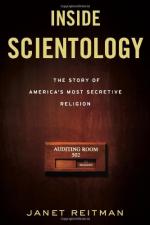|
This section contains 565 words (approx. 2 pages at 400 words per page) |

|
Inside Scientology: The Story of America's Most Secretive Religion Summary & Study Guide Description
Inside Scientology: The Story of America's Most Secretive Religion Summary & Study Guide includes comprehensive information and analysis to help you understand the book. This study guide contains the following sections:
This detailed literature summary also contains Topics for Discussion on Inside Scientology: The Story of America's Most Secretive Religion by Janet Reitman.
"Inside Scientology" is an in depth, albeit critical, look at the religious movement known as Scientology. Journalist Janet Reitman follows the religion throughout history to discover the inner workings of a controversial faith from its humble beginnings to its rise in power, slow breach with reality, and its near ending.
The author begins with an examination of the founder, L. Ron Hubbard, a science fiction writer who first found fame through his Dianetics therapy alternative to psychoanalysis. When he lost the rights to Dianetics, he reinvented it as a religion known as Scientology. From its beginnings, Scientology was designed as a tool for individuals to achieve higher self worth, more self-confidence, and an overall happier life. This was done through a series of audit sessions that helped the person overcome their weaknesses. At first, the movement was successful, but over time, L. Ron Hubbard began to seemingly lose his grip on reality. Feeling persecuted, he moved his base to ships on the ocean, creating his own world. He believed others were spying on him and were out to see the downfall of Scientology. Anxious for more followers, Hubbard "researched" and eventually discovered higher OT levels or higher levels of being where he claimed the secrets to the universe existed.
Scientology combated the IRS, the psychiatric systems, journalists, all government, many religions, and almost all other institutions both here and abroad. Hubbard arranged infiltration schemes where his own people would be inserted into almost every branch of government, where they would steal documents, and attempt to cover up any negative views of Scientology or any investigations into its finances. As a tax-exempt non-profit organization, Hubbard was always concerned that someone would show his own profit from his "church." Always seeking acceptance in the world, Hubbard continued his decline to the point where he no longer communicated with others, but instead used a series of messengers who spoke for him. One such messenger was David Miscavige, who eventually became one of the few people who had any access to Hubbard as he went into isolation. Over time, nearly all matters related to Scientology went through Miscavige prior to reaching Hubbard. It was no surprise, then, that after Hubbard's death, Miscavige took over. Unlike Hubbard, Miscavige cared little for public opinion. Although both men were prone to paranoia, Miscavige was also prone to violence and cruelty. Under his reign, Scientology became military like in its order, and prison like in its day to day operations. Miscavige cared little for the science of Scientology or the human aspect of the church, but focused solely on income. His elevation of celebrities over life long members of the church, his constant shifting of power among his staff, his inhumane treatment of staff members, and his complete lack of regard for anyone led many in the church to abandon the institution and escape the long arm of Miscavige and his leaders. Many of those who escaped still believe in Hubbard's teachings and many have launched their own Scientology networks, bypassing Miscavige, and bringing the focus back to Hubbard's original ideas.
"Inside Scientology" provides an in depth look at the religion from its origins to its near collapse and examines the forces that made and broke the church. Although somewhat critical in nature, the book does shed light on one of the most controversial religions in the world today.
Read more from the Study Guide
|
This section contains 565 words (approx. 2 pages at 400 words per page) |

|



